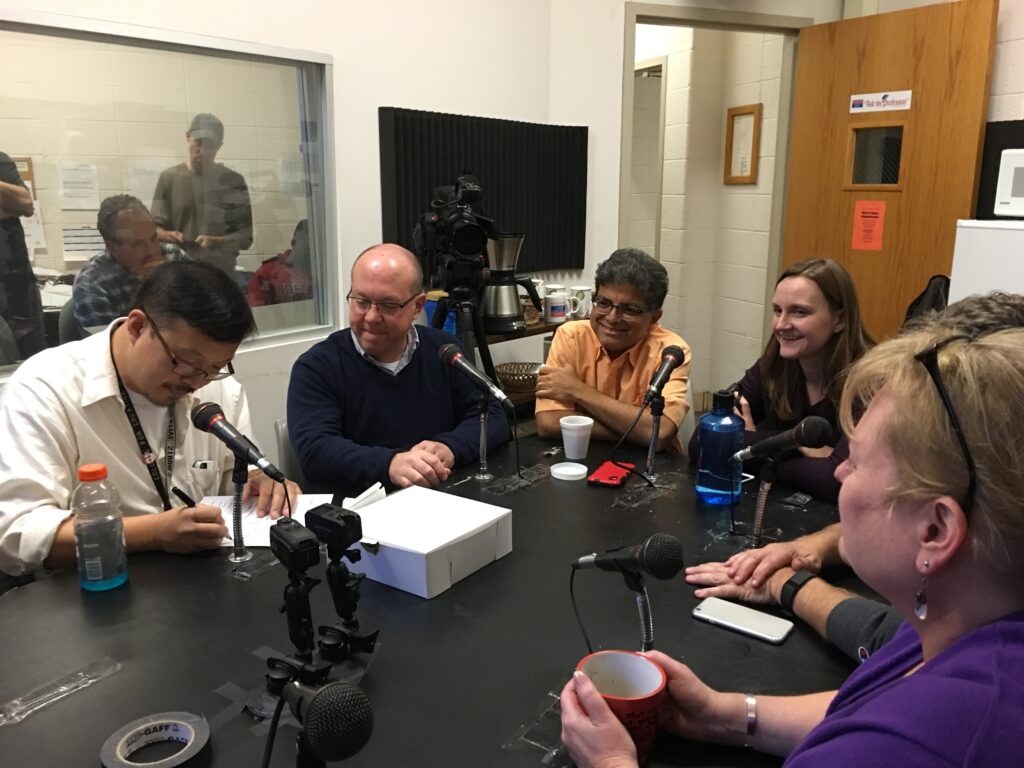 One of the longest running radio shows in the country, “Ask the Professor,” was established in 1953 at the University of Detroit (University of Detroit Mercy) and was originally broadcasted on WJR 760 among other stations.
One of the longest running radio shows in the country, “Ask the Professor,” was established in 1953 at the University of Detroit (University of Detroit Mercy) and was originally broadcasted on WJR 760 among other stations.
The current host of the show is chemistry and biochemistry professor Matthew J. Mio but has always featured faculty from history, philosophy, math, English, religion, chemistry and communication.
The foundation of the show has stuck throughout the years; the students ask questions, and the professors answer them, but the actualities of what is being asked has evolved.
In the beginning, questions ranged in specifics but were primarily educational based.
“There was no sense in trying to stump the professor,” Professor Mio said.
In the 1950s, to get a question answered, people would have to wait for a television station to air and hope their question would be answered or go to the library to look for it in a specific book or encyclopedia.
At the time, “Ask the Professor” was so useful since it was a much more time efficient in the sense of answers to questions.
The process of distributing the show nationally did not change much until the digital era. “Ask the Professor” had to be recorded on a tape, edited, mailed, played while being aired on the radio and sent back so that the process could be repeated.
Michael Jayson has been the producer for the show since he started working at the university in 1994. He described the process of how he would edit the audio so that it would be ready for air.
“You actually had to cut the tape physically, with a razor blade, to cut out what you didn’t want,” Jayson said.
Over time, the show has evolved.
“Slowly, but surely, I would say through the 60s, it started turning into more of a quiz show but I promise you at that time there would have been very little humor associated with it,” Mio said.
The show’s format and processes stayed consistent until the 1970s. Professor Edwin Dewindt became the host in 1974 and this is when “Ask the Professor” shifted into more of a comedy show but again the processes stayed the same.
“He just had the most wonderful baritone voice, very deep, and just had a way with words and a way to make things funny,” Mio said.
In 1999, Dewindt stepped down from being the host and the dean of the College of Liberal Arts and Education, Dr. Cathy Bush, took his place.
Dr. Bush had been the host for three years when Mio started working at the university in 2002 and the show was still exclusively airing on the radio.
When Dr. Bush had to step down in early 2010, a few professors took over to keep the show going until they found a new host, but it was becoming difficult for them to continue without her.
By late 2010, Mio took over the show and he has been the host since.
The difficulties airing on the radio started way before “Ask the Professor,” but they were unforeseen since there were no other options. The government mandated the times radio shows would be broadcasted but the specific times they would be broadcasted were never announced.
Listeners of “Ask the Professor” had to guess when it would be aired if they wanted to listen. The realization of those past difficulties became known when the show started podcasting.
Jayson can now use software to edit the show. To broadcast it, all he must do is upload it as an mp3 file, create a post and email it to the stations that air it.
Podcasting supported the growth of “Ask the Professor,” and it continues to do so.
“The digital age actually made it better because now you can listen to the show whenever you want to,” Mio said.
Professor Heather Hill has been a frequent feature on the show, and she believes that “Ask the Professor” stays relevant because it has had continuous support from the university.
“I think it’s embedded in the culture of this college as something we do,” she said. “It is very resilient in the sense that we used to be live and now we record live… and now it’s a podcast, so it’s there and available. I think it’s thriving to be honest.”
Over the years, the professors have preserved the roots of “Ask the Professor.” The show still has the same framework: students asking questions and professors answering them. To keep the originality of the show, the professors have continued to take a photo each year.
With that, they continue to give out a prize, it may not be an autographed photograph of a photographed autograph, but they do have “Ask the Professor” mugs now.



